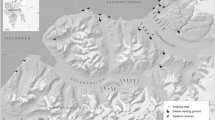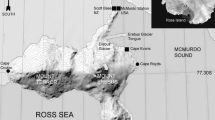Abstract
We studied predation risk in relation to nest location and subcolony size in Southern Rockhopper Penguins (Eudyptes chrysocome chrysocome) during the chick-rearing period. Striated Caracaras (Phalcoboenus australis), the main predator, preferentially attacked from tussock grasses which are found in the periphery of all subcolonies (peripheral tussocks) and often scattered within them (central tussocks). The greatest numbers of predation and attempted predation events were observed on nests in the periphery of the subcolony next to peripheral tussocks, and on those nests next to central tussocks. Central tussocks offer Striated Caracaras an additional “edge” area from which to prey, much in the same way as do the peripheral tussocks. Predation rate per individual was not correlated with subcolony size possibly due to the presence of central tussocks which, by creating an extra edge area, change the subcolony shape. There is a suggestion (P = 0.06) of increased probability of nest success with subcolony size.





Similar content being viewed by others
References
Ainley AG, LeResche RE, Sladen WJL (1983) Breeding biology of the Adélie Penguin. University of California Press, Berkeley
Anderson D J, Hodum PJ (1993) Predator behavior favors clumped nesting in an oceanic seabird. Ecology 74:2462–2464
Barbosa A, Moreno J, Potti J, Merino S (1997) Breeding group size, nest position and breeding success in the chinstrap penguin. Polar Biol 18:410–414
Bellinato F, Bogliani G (1995) Colonial breeding imposes increased predation: experimental studies with herons. Ethol Ecol Evol 7:347–353
Birdlife International (online)(2005) Species fact sheet: Phalcoboenus australis. http://www.birdlife.org(8 November 2005)
Brown CR, Brown MB (2001) Avian coloniality, progress and problems. Curr Ornithol 16:1–82
Brunton DH (1997) Impacts of predators: center nests are less successful than edge nests in a large colony of Least Terns. Condor 99:372–380
Brunton D (1999) “Optimal” colony size for Lest Terns: an intercolony study of opposing selective pressures by predators. Condor 101:607–615
Coulson JC (1968) Differences in the Quality of Birds nesting in the Center and on the Edges of a Colony. Nature 217:478–479
Davis L S (1982) Creching behaviour of Adélie penguin chicks (Pygoscelis adeliae). NZJ Zool 9:279–286
Descamps S, Gauthier-Claerc M, Le Bohec C, Gender JP, Le Maho Y (2005) Impact of predation on King Penguin Aptenodytes patagonicus in Crozet Archipelago. Polar Biol 28:303–310
Emslie SE, Karnovsky N, Trivelpiece W (1995) Avian predation at penguin colonies on King George Island, Antarctica. Wilson Bull 107:317–327
Hamilton WD (1971) Geometry for the selfish herd. J Theor Biol 31:295–311
Hernández-Matías A, Jover L, Ruiz X (2003) Predation on Common Tern Eggs in Relation to Sub-colon Size, Nest Aggregation and Breeding Synchrony. Waterbirds 23:280–289
Hernández-Matías A, Ruiz X (2003) Predation on common tern eggs by the yellow-legged gull at the Ebro Delta. Sci Mar (Barc) 67:95–101
Hunter S (1991) The impact of avian predator-scavengers on King Penguin Aptenodytes patagonicus chicks at Marion Island. Ibis 133:343–350
Jackson AL, Bearhop S, Thompson DR (2005) Shape can influence the rate of colony fragmentation in ground nesting seabirds. Oikos 111:473–478
Le Bohec C, Gauthier-Clerc M, Gender J-P, Chatelain N, Le Maho Y (2003) Nocturnal predation of king penguins by giant petrels on the Crozet Islands. Polar Biol 26:587–590
Meiburg JA (2006) The biogeography of Striated Caracaras Phalcoboenus australis. Unpublished Master of Arts thesis, The University of Texas at Austin
Narosky T, Yzurieta D (1987) Guía para la identificación de las aves de Argentina y Uruguay. Asociación Ornitológica del Plata. Buenos Aires
Pettingill Jr OS (1960) Crèche behavior and individual recognition in a colony of Rockhopper Penguins. Wilson Bull 72:213–221
Raya Rey A (2006) Ecología trofica de Eudyptes chrysocome chrysocome en el mar Austral. Unpublished PhD thesis, University of Buenos Aires
Raya Rey A, Trathan P, Schiavini A (2007) Inter-annual variation in provisioning behaviour of Southern Rockhopper Penguins Eudyptes chrysocome chrysocome at Staten Island, Argentina. Ibis (online early articles)
SAS version 9.1 (2006) SAS Institute Inc., Cary, NC
Schiavini A (2000) Staten Island, Tierra del Fuego: the largest breeding ground for Southern Rockhopper Penguins? Waterbirds 23:286–291
Spear LB (1993) Dynamics and effect of western gulls feeding in a colony of guillemots and Brandt’s cormorants. J Anim Ecol 62:399–414
St. Clair CC, St. Clair RC (1996) Causes and consequences of egg loss in rockhopper penguins, Eudyptes chrysocome. Oikos 77:459–466
Stokes DL, Boersma PD (2000) Nesting density and the reproductive success in a colonial seabird, the Magellanic Penguin. Ecology 81:2878–2891
Taylor RH (1962) The adelie penguin Pygoscelis adeliae at Cape Royds. Ibis 104:176–204
Tenaza R (1971) Behavior and nesting success relative to nest location in Adélie Penguins (Pygoscelis adeliae). Condor 73:81–92
Viñuela J, Moreno J, Carrascal LM, Sanz JJ, Ferrer M, Amat JA, Belliure J, Cuervo JJ (1996) The effect of hatching date on parental care, chick growth and chick mortality in the chinstrap penguin Pygoscelis antarctica. J Zool Lond 240:51–58
Wittenberger JF, HuntGL (1985) The adaptive significance of coloniality in birds. In: Farner DS, King JR, Parkes KC (eds) Avian Biology, vol. 8. Academic, New York, pp 1–78
Yorio P, Quintana F (1997) Predation by Kelp Gulls Larus dominicanus at a mixed-species colony of Royal Terns Sterna maxima and Cayenne Terns Sterna eurygnatha in Patagonia. Ibis 139:536–541
Young E (1994) Skua and penguin. Cambridge University Press, England
Acknowledgments
This research was completed as part of the senior author’s Masters thesis at UNCW. We thank M. Galizio and M. McCartney for their help and comments while serving on the thesis committee. We also thank Soledad Albanese, Carlos Cabrera, Christine Calleri, Carolina Gargiulo, Fernanda Malacrida, and Marcelo Turus for assistance in the field. We also thank Jonathan Meiburg and Andrea Raya Rey for sharing their observations on Striated Caracaras and Rockhopper Penguins at Staten Island. Funding for this research was provided in part by grants from the National Geographic Society (7040-01 and 7572-03) and NSF (OPP-0125098) to S. Emslie. We also appreciate the support of the Argentinean Navy and the “Ushuaia” tour vessel for transportation to and from Staten Island.
Author information
Authors and Affiliations
Corresponding author
Rights and permissions
About this article
Cite this article
Liljesthröm, M., Emslie, S.D., Frierson, D. et al. Avian predation at a Southern Rockhopper Penguin colony on Staten Island, Argentina. Polar Biol 31, 465–474 (2008). https://doi.org/10.1007/s00300-007-0372-1
Received:
Revised:
Accepted:
Published:
Issue Date:
DOI: https://doi.org/10.1007/s00300-007-0372-1




